Municipal elections 2008 – who were the candidates and who were elected?
The majority were men and represented the large age groups
A total of 38,509 candidates were nominated for the Municipal elections, which is 1,397 less than in 2004. The highest numbers of candidates were nominated by the Centre Party (9,977), the Social Democratic Party (7,702), the Coalition Party (7,628) and the Left Alliance (4,112). The Green League nominated 2,192 candidates, the Swedish People's Party 1,407, the Christian Democrats 1,921, the True Finns 1,840 and the Communist Party of Finland 362. For reasons of data protection, the candidates of small parties cannot be examined separately.
The majority, or 51.5 per cent, of the persons entitled to vote are women. Women make up 40.4 per cent of the candidates. The proportion of female candidates rose by 0.5 percentage points from the previous elections. Only the Greens had more female than male candidates (56.8 per cent). The next closest to a balanced situation were Christian Democrats with a 48.2 per cent proportion of female candidates. The proportion of women was around 40 per cent in the Coalition Party, the Centre Party and the Social Democratic Party. The percentage of female candidates was the highest in the Region of Uusimaa, at 43.9 per cent, and the lowest in North Karelia, at 37.1 per cent.
The proportion of women of the elected councillors is slightly smaller than their proportion of all candidates, namely 36.7 per cent. Of the new councillors elected in these elections 40.9 per cent are women.
Persons entitled to vote, candidates (by party) and elected councillors by gender in Municipal elections 2008, %
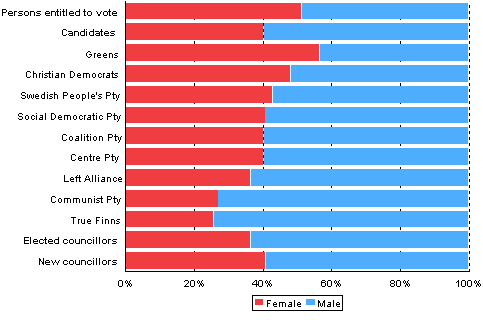
Persons entitled to vote, candidates (by party) and elected councillors by gender in Municipal elections 2008, %
| Female | Male | |
| Persons entitled to vote | 51.5 | 48.5 |
| Candidates | 40.4 | 59.6 |
| Greens | 56.8 | 43.2 |
| Christian Democrats | 48.2 | 51.8 |
| Swedish People's Pty | 42.9 | 57.1 |
| Social Democratic Pty | 40.8 | 59.2 |
| Coalition Pty | 40.3 | 59.7 |
| Centre Pty | 40.3 | 59.7 |
| Left Alliance | 36.6 | 63.4 |
| Communist Pty | 27.1 | 72.9 |
| True Finns | 25.7 | 74.3 |
| Elected councillors | 36.7 | 63.3 |
| New councillors | 40.9 | 59.1 |
Persons entitled to vote, candidates (by party) and elected councillors by age group in Municipal elections 2008, %
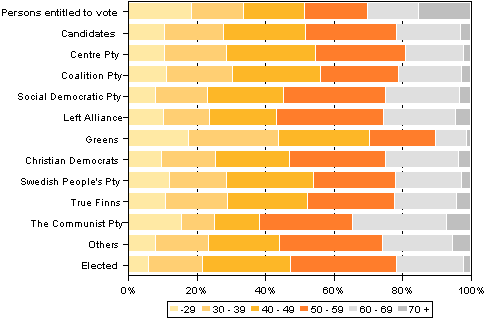
Elected councillors represent the age groups 40 to 49 and 50 to 59 slightly more often than the candidates. A total of 6.2 per cent of the elected councillors are under 30 years of age and 2 per cent are over 70 years of age.
Persons entitled to vote, candidates (by party) and elected councillors by age group in Municipal elections 2008, %
| -29 | 30-39 | 40-49 | 50-59 | 60-69 | 70 + | |
| Persons entitled to vote | 18.7 | 15.2 | 17.7 | 18.4 | 14.9 | 15.2 |
| Candidates | 10.7 | 17.4 | 23.8 | 26.5 | 18.7 | 2.9 |
| Centre Pty | 10.8 | 18.2 | 25.8 | 26.2 | 17.0 | 2.1 |
| Coalition Pty | 11.4 | 19.3 | 25.5 | 22.9 | 18.2 | 2.7 |
| Social Democratic Pty | 8.2 | 15.0 | 22.4 | 29.7 | 21.6 | 3.2 |
| Left Alliance | 10.4 | 13.4 | 19.7 | 31.1 | 21.1 | 4.3 |
| Greens | 17.8 | 26.2 | 26.6 | 19.2 | 9.0 | 1.2 |
| Christian Democrats | 9.8 | 15.8 | 21.6 | 28.0 | 21.3 | 3.5 |
| Swedish People's Pty | 12.2 | 16.7 | 25.2 | 23.9 | 19.4 | 2.6 |
| True Finns | 11.1 | 18.1 | 23.3 | 25.4 | 18.2 | 4.0 |
| The Communist Pty | 15.8 | 9.4 | 13.1 | 27.2 | 27.5 | 6.9 |
| Others | 8.0 | 15.5 | 20.8 | 30.1 | 20.2 | 5.3 |
| Elected councillors | 6.2 | 15.7 | 25.7 | 30.9 | 19.5 | 2.0 |
The size of the municipality affects the party structure so that small municipalities have the highest proportions of candidates from the Centre Party. In municipalities with less than 2,000 inhabitants 43 per cent of candidates were nominated by the Centre Party, 23 per cent by the Coalition Party, 14 per cent by the Social Democrats and 6 per cent by the Left Alliance. In municipalities with 2,000-4,999 inhabitants, 41 per cent of the candidates were from the Centre Party, 17 per cent from the Coalition Party, and 17 per cent from the Social Democratic Party. The Centre Party had the highest proportion of candidates also in municipalities with up to 10,000-19,999 inhabitants (26 per cent). The Coalition Party and the Social Democratic Party candidates made up equal proportions of 22 per cent. In municipalities with over 20,000 inhabitants, the candidates of both the Coalition Party and the Social Democratic Party outnumbered those of the Centre Party. In municipalities with over 100,000 inhabitants only 13 per cent of candidates were nominated by the Centre Party, while 16 per cent were nominated by both the Coalition Party and the Social Democrats, 15 per cent by the Green League and 14 per cent by the Left Alliance. The Green League and the Left Alliance clearly concentrated their candidate nominations into large municipalities.
Proportion of candidates and elected councillors of age group in Municipal elections 2008, ‰
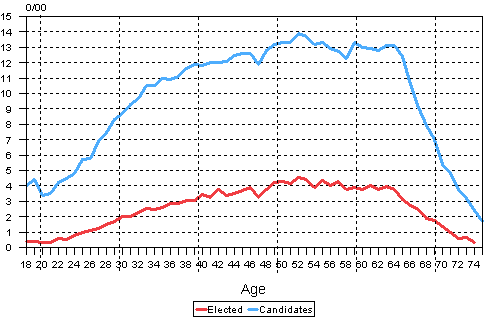
Candidates (by party) by size of municipality in Municipal elections 2008, %
| Total | -1,999 | 2,000-4,999 | 5,000-9,999 | 10,000-19,999 | 20,000-49,999 | 50,000-99,999 | 100,000 + | |
| Candidates | 100.0 | 100.0 | 100.0 | 100.0 | 100.0 | 100.0 | 100.0 | 100.0 |
| Centre Pty | 25.9 | 43.1 | 40.8 | 32.7 | 25.7 | 17.4 | 18.2 | 12.5 |
| Coalition Pty | 19.8 | 23.1 | 16.6 | 18.8 | 22.4 | 21.1 | 23.2 | 15.9 |
| Social Democratic Pty | 20.0 | 14.4 | 16.7 | 18.8 | 21.7 | 24.3 | 22.5 | 15.9 |
| Left Alliance | 10.7 | 6.4 | 7.7 | 10.9 | 9.5 | 12.4 | 10.2 | 14.4 |
| Green League | 5.7 | 1.2 | 1.7 | 2.6 | 4.2 | 7.1 | 7.8 | 15.1 |
| Christian Democrats | 5.0 | 2.7 | 4.1 | 4.3 | 5.0 | 5.7 | 6.1 | 5.9 |
| Swedish People's Pty | 3.7 | 2.5 | 2.9 | 4.4 | 4.0 | 3.3 | 1.6 | 5.9 |
| True Finns | 4.8 | 3.2 | 5.5 | 4.5 | 5.6 | 3.6 | 4.1 | 6.4 |
| Communist Pty | 0.9 | 0.1 | 0.1 | 0.0 | 0.3 | 1.5 | 1.0 | 3.6 |
| Others | 3.6 | 3.4 | 3.9 | 3.1 | 1.7 | 3.8 | 5.3 | 4.4 |
The differences in the ages of candidates by party were fairly small: the average age of female candidates from all parties was 2 to 3 years lower than that of male candidates, with the exception of the Green League. The number of male candidates was the highest in the 50 to 59-year-old age group, and that of female candidates in the 40 to 49-year-old age group. The number of 50 to 65-year-olds among the candidates exceeded their proportion of the whole population. The numbers of candidates from the over 65-year-old and under 35-year-old age groups were clearly lower than their proportion of the whole population. The 50 to 55-year-olds were the most eager to be nominated as candidate.
Age distribution and average age of persons entitled to vote and candidates by gender in Municipal elections 2008, %
| Persons entitled to vote | Candidates |
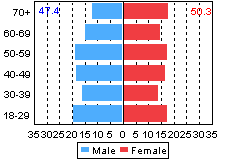 |
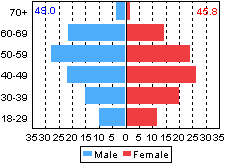 |
Age distribution and average age of candidates by gender and party in Municipal elections 2008, %
| Social Democratic Party of Finland | Centre Party of Finland |
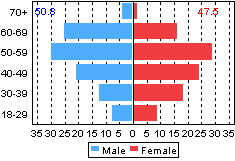 |
 |
| National Coalition Party of Finland | Christian Democrats in Finland |
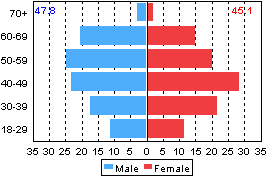 |
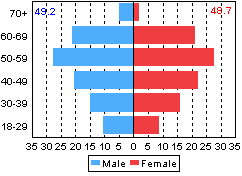 |
| Green League | Swedish People's Party in Finland |
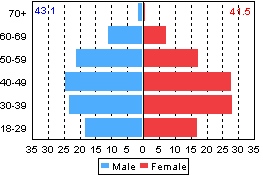 |
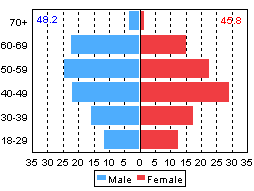 |
| True Finns | The Communist Party Of Finland |
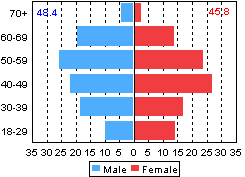 |
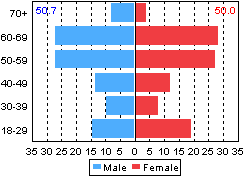 |
| Left Alliance | |
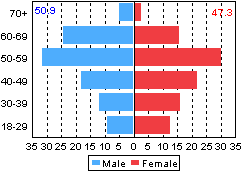 |
Age distribution and average age of elected councillors by gender in Municipal elections 2008, %
| Elected councillors |
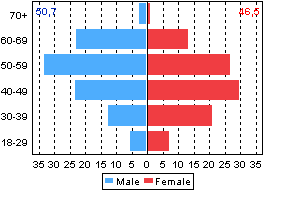 |
The average age of persons entitled to vote had risen by one year since the previous Municipal elections. On the election day the average age of persons entitled to vote was now 47.4 years for men and 50.3 for women. The average age of male candidates had risen by 1.3 years and that of women candidates by one year. The average age of male candidates was now 49.0 years and that of female candidates 45.8 years. Female candidates were, on average, 4.5 years younger than female voters, whereas male candidates were 1.6 years older than male voters.
Most male candidates represented the 50 to 59-year-old age group and most female candidates the 40 to 49-year-old age group. The Social Democrats and the left Alliance had the oldest male candidates with an average age of 51 years. The oldest female candidates represented the Communist Party of Finland (precisely 50 years) and the Christian Democrats (48.7 years). The Green League nominated the youngest male and female candidates at 43.1 and 41.5 years, respectively. The average age of Coalition Party male candidates was 47.8 years and that of their female candidates 45.1 years, the respective ages of Centre Party candidates were 48.5 and 44.8 years.
The average age of elected male councillors is 50.7 years and that of female councillors 46.5 years. Most male councillors represent the 50 to 59-year-old age group and most female councillors the 40 to 49-year-old age group.
Few candidates of foreign origin
The language distribution among the candidates mirrored, by and large, the language distribution of the population in the regions. The proportion of Swedish-speaking candidates (5.2 per cent) slightly exceeded their proportion of persons entitled to vote (4.9 per cent). Swedish-speaking people were more active in the Region of Uusimaa, where their proportion of candidates was 12 per cent and that of persons entitled to vote 7.4 per cent. Persons speaking a language other than the two official languages of Finland can be classified as being of foreign origin. Their proportion among persons entitled to vote was 3.2 per cent and that among candidates was 1.5 per cent. These percentages correspond to slightly less than one-half of their share of the population. The deficit of foreign persons among all candidates was 1.7 percentage points. In Uusimaa it was 3.5 and in Varsinais-Suomi 2.1 percentage points. The number of candidates of foreign origin was thus smaller then their share of the population. The two exceptions were Kainuu and Central Ostrobothnia, where the number of candidates of foreign origin slightly exceeded their share of the population.
Only very few candidates of foreign origin were elected, namely 0.3 per cent, which is one-tenth of their share of the population. This figure translates to 34 councillors in the whole country. In Uusimaa the share of elected councillors of foreign origin is 0.9 per cent. In Uusimaa the proportion of elected Swedish-speaking councillors is 15.1 per cent, which is twice as much as the share of Swedish-speaking persons entitled to vote.
Persons entitled to vote, candidates and elected councillors by native language by region in Municipal elections 2008, %
| Region | Persons entitled to vote | Candidates | Elected councillors | ||||||
| Finnish, Sami | Swedish | Other language | Finnish, Sami | Swedish | Other language | Finnish, Sami | Swedish | Other language | |
| WHOLE COUNTRY | 91.8 | 4.9 | 3.2 | 93.4 | 5.2 | 1.5 | 93.2 | 6.5 | 0.3 |
| Uusimaa | 86.1 | 7.4 | 6.5 | 85.0 | 12.0 | 3.0 | 83.9 | 15.1 | 0.9 |
| Itä-Uusimaa | 64.1 | 33.1 | 2.8 | 67.7 | 30.9 | 1.3 | 63.0 | 36.7 | 0.4 |
| Varsinais-Suomi | 90.8 | 5.7 | 3.5 | 92.6 | 6.0 | 1.4 | 93.0 | 6.6 | 0.3 |
| Satakunta | 98.4 | 0.3 | 1.2 | 98.8 | 0.2 | 1.0 | 99.7 | 0.2 | 0.2 |
| Kanta-Häme | 97.8 | 0.4 | 1.8 | 98.5 | 0.3 | 1.3 | 99.2 | 0.5 | 0.3 |
| Pirkanmaa | 97.1 | 0.3 | 2.5 | 98.4 | 0.3 | 1.3 | 99.3 | 0.4 | 0.4 |
| Päijät-Häme | 97.1 | 0.3 | 2.6 | 97.5 | 0.4 | 2.1 | 98.2 | 0.8 | 1.0 |
| Kymenlaakso | 96.6 | 0.8 | 2.6 | 97.0 | 1.2 | 1.8 | 98.1 | 1.9 | 0.0 |
| South Karelia | 97.2 | 0.1 | 2.7 | 98.3 | 0.2 | 1.5 | 99.7 | 0.0 | 0.3 |
| Etelä-Savo | 98.3 | 0.2 | 1.5 | 98.7 | 0.1 | 1.2 | 99.8 | 0.0 | 0.2 |
| Pohjois-Savo | 98.7 | 0.1 | 1.2 | 98.9 | 0.1 | 1.0 | 99.5 | 0.2 | 0.3 |
| North Karelia | 98.2 | 0.1 | 1.7 | 98.4 | 0.3 | 1.4 | 98.6 | 0.7 | 0.7 |
| Central Finland | 98.1 | 0.2 | 1.7 | 98.6 | 0.2 | 1.3 | 100.0 | 0.0 | 0.0 |
| South Ostrobothnia | 98.9 | 0.3 | 0.8 | 99.5 | 0.1 | 0.3 | 99.8 | 0.2 | 0.0 |
| Ostrobothnia | 46.4 | 50.8 | 2.8 | 48.7 | 49.4 | 1.8 | 33.4 | 66.0 | 0.6 |
| Central Ostrobothnia | 89.6 | 9.4 | 1.1 | 89.9 | 8.7 | 1.3 | 94.6 | 5.4 | 0.0 |
| North Ostrobothnia | 98.5 | 0.1 | 1.4 | 99.1 | 0.2 | 0.8 | 99.7 | 0.1 | 0.2 |
| Kainuu | 98.7 | 0.1 | 1.2 | 98.0 | 0.1 | 1.8 | 100.0 | 0.0 | 0.0 |
| Lapland | 98.5 | 0.2 | 1.3 | 98.9 | 0.3 | 0.8 | 99.8 | 0.2 | 0.0 |
Candidates' educational level is high
Persons entitled to vote, candidates (by party) and elected councillors by level of education in Municipal elections 2008, %
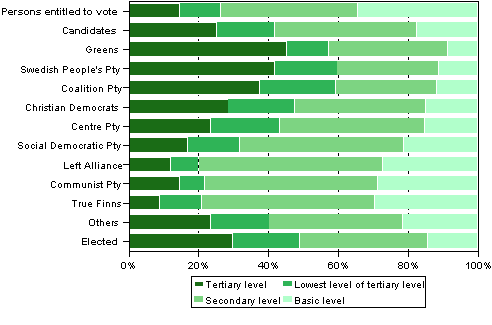
Persons entitled to vote, candidates (by party) and elected councillors by level of education in Municipal elections 2008, %
| Tertiary level |
Lowest level of tertiary level |
Secondary level |
Basic level |
|
| Persons entitled to vote | 14.8 | 11.5 | 39.2 | 34.4 |
| Candidates | 25.3 | 16.7 | 40.6 | 17.4 |
| Greens | 45.4 | 12.0 | 34.0 | 8.5 |
| Swedish People's Pty | 41.9 | 17.9 | 29.0 | 11.2 |
| Coalition Pty | 37.7 | 21.7 | 28.8 | 11.7 |
| Christian Democrats | 28.6 | 19.0 | 37.6 | 14.8 |
| Centre Pty | 23.7 | 19.7 | 41.5 | 15.1 |
| Social Democratic Pty | 17.1 | 14.7 | 47.1 | 21.2 |
| Left Alliance | 12.1 | 8.0 | 52.8 | 27.2 |
| Communist Pty | 14.7 | 7.2 | 49.4 | 28.6 |
| True Finns | 9.1 | 12.0 | 49.3 | 29.6 |
| Others | 23.5 | 16.8 | 38.3 | 21.3 |
| Elected councillors | 29.8 | 19.2 | 36.7 | 14.3 |
As regards education, candidates differed clearly from all persons entitled to vote. Of the candidates 82.6 per cent have attained a higher educational level than the basic level, while 65.6 per cent of all persons entitled to vote have some post basic level education. The proportion of the educated has risen by three percentage points. Fifteen per cent of the persons entitled to vote have a university or polytechnic degree. The respective proportion of the candidates is 25 per cent.
The proportion of candidates with university or polytechnic degrees was the highest in the Green League, at 45 per cent. The respective proportion in the Swedish People's Party was 42 per cent, in the Coalition Party 38 per cent, in the Christian Democrats 29 per cent and in the Centre Party 24 per cent.
Forty-seven per cent of the Social Democratic candidates have a secondary level degree. The respective proportion in the Left Alliance is 53 per cent and in the Communist Party and True Finns 49 per cent. The educational level of the Municipal election candidates reflected the differences in the educational structure of different areas. The proportion of the highly educated is usually double in Uusimaa when compared with the least educated areas.
Of the elected councillors 29.8 per cent hold a lower of higher tertiary degree and 19.2 per cent a lowest level tertiary qualification. Among elected councillors the proportion of persons with at least a lowest level tertiary qualification is nearly twice as high as among persons entitled to vote. Elected councillors have a secondary level education slightly less often and a basic level education 20 percentage points less often than persons entitled to vote.
Majority of candidates live in families with children
Thirty-two per cent of the persons entitled to vote live in the same household with their married or cohabiting spouse and children. Of the candidates 46 per cent live in such families. In addition, 30 per cent of the candidates live together with just their married or cohabiting spouse and entirely without children. The proportion of candidates living in families with their married spouse was 63 per cent and that of candidates living with their cohabiting spouse 13 per cent. Of the persons entitled to vote, 50 per cent are married couples and 15 per cent cohabit. Single parents made up 6.7 per cent of the candidates and singles, that is, persons not belonging to families, made up 17.4 per cent, which was three percentage points more than in the previous elections. Of the persons entitled to vote, 29 per cent live in one-person households. Their number equals that of persons living in families with children. The number of persons living alone has grown in most parties. They made up one-fourth of the candidates of the Green League.
The proportions of married candidates were 78 per cent in the Christian Democrats, 70 per cent in the Centre Party, 68 per cent in the Coalition Party and the Swedish People's Party and 60 per cent in the Social Democratic Party. The proportion of candidates living with their cohabiting spouse was highest (at 18 per cent) in the Green League and the Communist Party. Among the persons entitled to vote, the proportion of persons living alone and not belonging to a family is 28.9 per cent.
The difference between persons entitled to vote and elected councillors was perhaps most marked in family type. Of persons entitled to vote 32.4 per cent live in families with children, while the corresponding percentage among the elected councillors is 53.7 per cent. The number of cohabiting couples is nearly the same among elected councillors and persons entitled to vote, but the number of persons living alone is only 10.7 among elected councillors and 29.8 per cent among persons entitled to vote.
Persons entitled to vote, candidates (by party) and elected councillors by family type in Municipal elections 2008, %
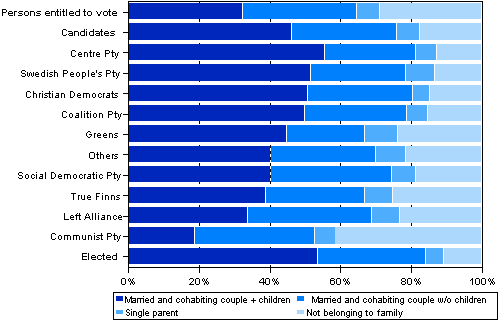
Persons entitled to vote, candidates (by party) and elected councillors by family type in Municipal elections 2008, %
| Married and cohabiting couple + children |
Married and cohabiting couple w/o children |
Single parent |
Not belonging to a family |
|
| Persons entitled to vote | 32.4 | 32.2 | 6.5 | 28.9 |
| Candidates | 46.4 | 29.5 | 6.7 | 17.4 |
| Centre Pty | 55.5 | 25.9 | 6.0 | 12.6 |
| Swedish People's Pty | 51.7 | 26.9 | 8.0 | 13.4 |
| Christian Democrats | 50.7 | 29.6 | 4.9 | 14.7 |
| Coalition Pty | 49.9 | 28.9 | 6.0 | 15.2 |
| Greens | 45.0 | 22.0 | 9.3 | 23.8 |
| Others | 40.4 | 29.6 | 8.6 | 21.5 |
| Social Democratic Pty | 40.3 | 34.2 | 6.8 | 18.7 |
| True Finns | 39.0 | 28.0 | 7.9 | 25.1 |
| Left Alliance | 33.8 | 35.2 | 7.7 | 23.3 |
| Communist Pty | 18.9 | 33.9 | 5.8 | 41.4 |
| Elected councillors | 53.7 | 30.6 | 5.1 | 10.7 |
More children than on average
Family type does not reveal how many of the candidates have or have had children of their own, because in older families, in case of divorce, etc., children can live apart from the candidates. The number of biological children indicates how many candidates have experience with children of their own. Of all persons entitled to vote, 34.8 per cent have never had children of their own. The respective proportion of the candidates is 21.3 per cent. The number of childless candidates varies from 18.3 per cent for the Social Democrats to 32.8 per cent for the Green League. The Green League had numerous young candidates, who may not have any children yet. Large families are the most numerous among Christian Democrats, of whom 22.7 per cent have at least four children, and among Centre Party candidates, of whom 16.9 per cent have four or more children. Large families are rarest among the Communist Party, the Green League and the Social Democrats. The candidates' number of children reflects the birth rate in the area, which means that the number of large families is highest in Ostrobothnia and Kainuu and the smallest families are found in Varsinais-Suomi, Uusimaa, Kymenlaakso and South Karelia.
Of the candidates 77.7 per cent have biological children, whereas the corresponding percentage of persons entitled to vote is 65.2. The proportion of childless candidates grew by a couple of percentage points from the previous Municipal elections.
Persons entitled to vote, candidates (by party) and elected councillors by number of biological children in Municipal elections 2008, %
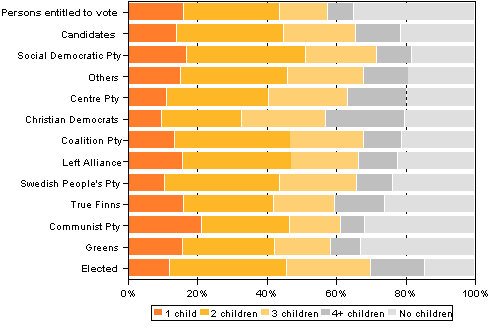
Elected councillors generally have children. Only 14.5 per cent of them have no children, while 34.8 per cent of persons entitled to vote do not have children living at home. In addition, 15.5 per cent of elected councillors have four or more children, while the respective percentage among persons entitled to vote is only 7.5.
Persons entitled to vote, candidates (by party) and elected councillors by number of biological children in Municipal elections 2008, %
| 1 child | 2 children | 3 children | 4+ children | No children | |
| Persons entitled to vote | 16.1 | 27.6 | 14.0 | 7.5 | 34.8 |
| Candidates | 14.0 | 30.8 | 21.0 | 12.9 | 21.3 |
| Social Democratic Pty | 17.1 | 34.1 | 20.5 | 9.9 | 18.3 |
| Others | 15.4 | 30.6 | 21.9 | 12.9 | 19.2 |
| Centre Pty | 11.2 | 29.3 | 22.9 | 16.9 | 19.7 |
| Christian Democrats | 9.9 | 23.0 | 24.2 | 22.7 | 20.1 |
| Coalition Pty | 13.4 | 33.4 | 21.3 | 10.7 | 21.2 |
| Left Alliance | 15.8 | 31.3 | 19.4 | 11.2 | 22.3 |
| Swedish People's Pty | 10.6 | 33.2 | 22.1 | 10.4 | 23.7 |
| True Finns | 16.2 | 25.8 | 17.8 | 14.4 | 25.9 |
| Communist Pty | 21.4 | 25.3 | 14.7 | 6.9 | 31.7 |
| Greens | 15.9 | 26.3 | 16.1 | 8.8 | 32.8 |
| Elected councillors | 12.1 | 33.7 | 24.2 | 15.5 | 14.5 |
Employment problems rare
Over one-half of those entitled to vote are employed (54.5 per cent), 5.8 per cent are unemployed, 26.7 per cent are pensioners and 8.2 per cent are students or engaged in domestic work. The proportion of the employed has stayed level and that of the unemployed has fallen slightly from the previous elections. Of the candidates clearly more were employed (74 per cent), slightly fewer were unemployed (5.3 per cent) and clearly fewer were pensioners (12.9 per cent). However, pensioner candidates numbered one percentage point more than in the previous Municipal elections.
The numbers of employed candidates were the highest in the Swedish People's Party (80.9 per cent), the Coalition Party (78.8 per cent) and the Centre Party (78.5 per cent), all of which clearly exceeded the Government's 75 per cent employment objective. In these parties unemployment is also rarer than average. The candidates of the Social Democratic Party, the Green League and the Christian Democrats had been affected by unemployment as often as the persons entitled to vote, whereas the candidates of the Left Alliance, the True Finns and the Communist Party have been had been unemployed more often than average. The Greens had relatively the largest proportion of student candidates (11.8 per cent). The proportion of pensioner candidates was highest among the True Finns and the Communist Party.
Persons entitled to vote, candidates (by party) and elected councillors by main type of activity in Municipal elections 2008, %
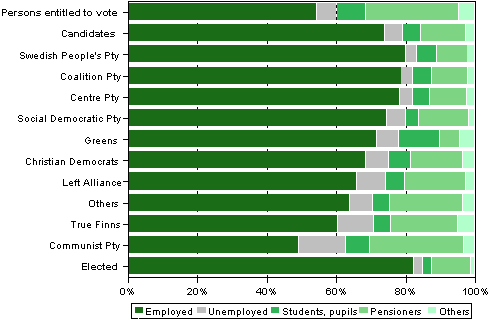
Persons entitled to vote, candidates (by party) and elected councillors by main type of activity in Municipal elections 2008, %
| Employed | Unemployed | Students, pupils |
Pensioners | Others | |
| Persons entitled to vote | 54.5 | 5.8 | 8.2 | 26.7 | 4.7 |
| Candidates | 74.0 | 5.3 | 5.3 | 12.9 | 2.6 |
| Swedish People's Pty | 80.2 | 3.1 | 5.7 | 8.9 | 2.2 |
| Coalition Pty | 78.8 | 3.2 | 5.5 | 10.4 | 2.1 |
| Centre Pty | 78.5 | 3.7 | 4.8 | 10.6 | 2.4 |
| Social Democratic Pty | 74.6 | 5.6 | 3.7 | 14.4 | 1.7 |
| Greens | 71.7 | 6.3 | 11.8 | 5.9 | 4.3 |
| Christian Democrats | 68.6 | 6.8 | 6.1 | 15.1 | 3.5 |
| Left Alliance | 66.0 | 8.3 | 5.5 | 17.6 | 2.5 |
| Others | 63.9 | 6.9 | 4.8 | 21.0 | 3.5 |
| True Finns | 60.4 | 10.4 | 4.9 | 19.3 | 5.0 |
| Communist Pty | 49.2 | 13.6 | 6.9 | 26.9 | 3.3 |
| Elected councillors | 82.3 | 2.8 | 2.6 | 11.0 | 1.3 |
Among the elected councillors the proportion of the employed is 28 percentage points higher than among persons entitled to vote (at 82.3 per cent). The numbers of the unemployed and students among elected councillors are one-half and one-third, respectively, of their numbers among the persons entitled to vote. Of the elected councillors, 11 per cent are pensioners. The respective percentage among the persons entitled to vote is 26.7.
Employment rate of persons entitled to vote, candidates and elected councillors (aged 18 to 64) by region in Municipal elections 2008, %
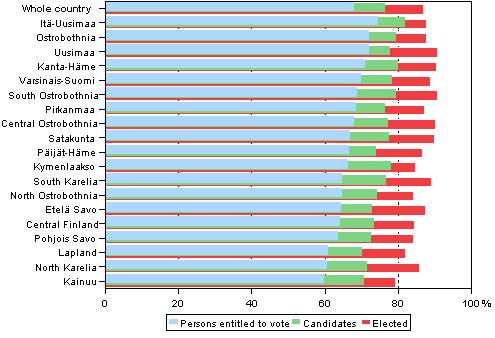
Employment rate of persons entitled to vote, candidates and elected councillors (aged 18 to 64) by region in Municipal elections 2008, %
| Persons entitled to vote | Candidates | Elected councillors | |
| WHOLE COUNTRY | 68.4 | 76.6 | 87.2 |
| Itä-Uusimaa | 74.8 | 82.2 | 88.0 |
| Ostrobothnia | 72.4 | 79.6 | 87.9 |
| Uusimaa | 72.3 | 78.2 | 91.0 |
| Kanta-Häme | 71.2 | 80.4 | 90.7 |
| Varsinais-Suomi | 70.2 | 78.7 | 89.0 |
| South Ostrobothnia | 69.0 | 79.8 | 91.0 |
| Pirkanmaa | 68.7 | 76.7 | 87.5 |
| Central Ostrobothnia | 68.2 | 77.6 | 90.4 |
| Satakunta | 67.2 | 77.7 | 90.0 |
| Päijät-Häme | 66.8 | 74.4 | 86.8 |
| Kymenlaakso | 66.5 | 78.4 | 85.0 |
| South Karelia | 65.1 | 77.0 | 89.2 |
| North Ostrobothnia | 64.9 | 74.6 | 84.3 |
| Etelä-Savo | 64.7 | 73.1 | 87.6 |
| Central Finland | 64.4 | 73.8 | 84.6 |
| Pohjois-Savo | 63.9 | 73.0 | 84.3 |
| Lapland | 61.3 | 70.5 | 82.3 |
| North Karelia | 61.0 | 71.9 | 85.9 |
| Kainuu | 60.0 | 71.1 | 79.4 |
In the regions of Itä-Uusimaa and Ostrobothnia the employment rate of the candidates differed the least from that of the persons entitled to vote; the difference stood at 6 to 8 percentage points. The difference between the candidates and the persons entitled to vote was biggest, at some 11 to 12 percentage points, in Kymenlaakso, South Karelia and Kainuu. Only Itä-Uusimaa has nearly reached the Government's 75 per cent employment objective among the persons entitled to vote. Farthest away from the objective is the employment rate of Kainuu, which stands at 60 per cent. The highest employment rate among the candidates was recorded in Itä-Uusimaa, where it stood at 82 per cent. All other regions (apart from Lapland and Kainuu) also came close to the Government's employment objective. Lapland and Kainuu fell the most short of the objective.
The elected councillors are even more often employed. In Uusimaa, Kanta-Häme, South and Central Ostrobothnia and Satakunta the employment rate among the elected councillors exceeds 90 per cent. Even at its lowest, in Kainuu, the employment rate stands at 79.4 per cent.
The public sector employs candidates
Persons entitled to vote, candidates (by party) and elected councillors by employer's sector in Municipal elections 2008, %
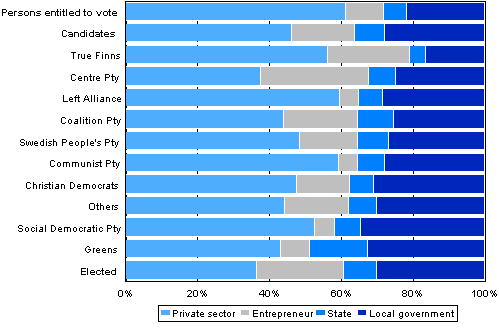
Persons entitled to vote, candidates (by party) and elected councillors by employer's sector in Municipal elections 2008, %
| Private sector |
Entrepreneur | State | Local government |
|
| Persons entitled to vote | 61.4 | 10.5 | 6.5 | 21.6 |
| Candidates | 46.4 | 17.5 | 8.2 | 27.8 |
| True Finns | 56.5 | 22.7 | 4.5 | 16.4 |
| Centre Pty | 37.6 | 30.2 | 7.4 | 24.8 |
| Left Alliance | 59.8 | 5.1 | 6.7 | 28.4 |
| Coalition Pty | 44.0 | 20.8 | 9.9 | 25.3 |
| Swedish People's Pty | 48.5 | 16.3 | 8.6 | 26.6 |
| Communist Pty | 59.5 | 5.2 | 7.5 | 27.7 |
| Christian Democrats | 47.7 | 14.7 | 6.7 | 30.9 |
| Others | 44.4 | 17.7 | 7.9 | 30.0 |
| Social Democratic Pty | 52.8 | 5.5 | 7.4 | 34.3 |
| Greens | 43.4 | 8.1 | 16.1 | 32.5 |
| Elected councillors | 36.6 | 24.3 | 9.1 | 30.0 |
Of the candidates 68 per cent are employed. Forty-six per cent of them are private sector wage and salary earners, 18 per cent are entrepreneurs and 8 per cent work for the state and 28 per cent for local government. Employer type varies significantly by party. The highest proportions of private sector wage and salary earners were found among the candidates of the Left Alliance and the Communist Party (60 per cent), the True Finns (57 per cent) and the Social Democrats (53 per cent). The lowest proportion of private sector wage and salary earners was found among the Centre Party candidates (38 per cent). Thirty per cent of the Centre Party candidates are entrepreneurs, the majority of whom are likely to operate in agriculture. The lowest proportions of entrepreneurs (only 5 per cent) were found in the Communist Party and the Social Democrats. Green League candidates are most often employed by the public sector: 33 per cent receive their wages from local government and 16 from the state. The next highest proportion of public sector employees was found among the Social Democrats, of whom 34 per cent work for local government and 7 per cent for the state. Of the True Finns only 16 per cent work for local government and 5 per cent for the state.
The public sector employs the most candidates in large municipalities, where as many as 41 per cent earn their wages and salaries in local government or state service. The most important employers in small municipalities are the private sector and entrepreneurship. In municipalities with less than 2,000 inhabitants the public sector accounts for 30 per cent and the private sector (incl. entrepreneurs) for 70 per cent.
Of the elected councillors 30 per cent work for the local government, 9.1 per cent for the state, 24.3 per cent are entrepreneurs and 36.6 per cent are employed in the private sector.
Candidates by employer's sector in municipalities of different size classes in Municipal elections 2008, %
| Size of municipality | Private | Entrepreneur | State | Local government | Public sector, total |
| -1,999 | 38.1 | 32.0 | 5.0 | 24.9 | 29.9 |
| 2,000-4,999 | 41.4 | 26.7 | 5.6 | 26.2 | 31.8 |
| 5,000-9,999 | 44.0 | 22.3 | 6.2 | 27.4 | 33.7 |
| 10,000-19,999 | 46.1 | 18.2 | 7.1 | 28.7 | 35.7 |
| 20,000-49,999 | 51.1 | 11.8 | 8.3 | 28.8 | 37.1 |
| 50,000-99,999 | 46.9 | 12.0 | 10.5 | 30.6 | 41.1 |
| 100,000 + | 51.8 | 6.7 | 15.8 | 25.6 | 41.4 |
| Total | 46.4 | 17.5 | 8.2 | 27.8 | 36.0 |
Elected councillors by employer's sector in municipalities of different size classes in municipal elections 2008, %
| Size of municipality | Private | Entrepreneur | State | Local government | Total |
| -1,999 | 33.3 | 36.8 | 6.3 | 23.7 | 100.0 |
| 2,000-4,999 | 34.4 | 32.3 | 6.3 | 27.0 | 100.0 |
| 5,000-9,999 | 36.1 | 27.3 | 7.6 | 29.0 | 100.0 |
| 10,000-19,999 | 36.2 | 23.6 | 8.2 | 32.0 | 100.0 |
| 20,000-49,999 | 39.6 | 15.2 | 10.1 | 35.0 | 100.0 |
| 50,000-99,999 | 38.1 | 13.2 | 13.7 | 34.9 | 100.0 |
| 100,000 + | 43.2 | 5.2 | 26.6 | 24.9 | 100.0 |
| Total | 36.6 | 24.3 | 9.1 | 30.0 | 100.0 |
In small municipalities (agricultural) entrepreneurs make up the majority of elected councillors. In the largest municipalities the majority are private sector wage and salary earners. The number of state and local government employees is highest, over one half of elected councillors, in municipalities with over 100,000 inhabitants.
Income higher than that of persons entitled to vote
Average income (EUR) of persons entitled to vote, candidates and elected councillors by region in Municipal elections 2008
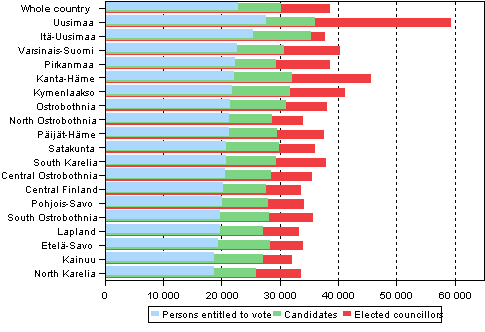
Average income (EUR) of persons entitled to vote, candidates and elected councillors by region in Municipal elections 2008
| Persons entitled to vote | Candidates | Elected councillors | |
| Whole country | 22,994 | 30,344 | 38,753 |
| Uusimaa | 27,745 | 36,128 | 59,613 |
| Itä-Uusimaa | 25,573 | 35,593 | 38,004 |
| Varsinais-Suomi | 22,905 | 30,912 | 40,521 |
| Pirkanmaa | 22,427 | 29,542 | 38,846 |
| Kanta-Häme | 22,362 | 32,289 | 45,754 |
| Kymenlaakso | 22,037 | 31,996 | 41,300 |
| Ostrobothnia | 21,582 | 31,206 | 38,247 |
| North Ostrobothnia | 21,423 | 28,870 | 34,149 |
| Päijät-Häme | 21,389 | 29,705 | 37,676 |
| Satakunta | 20,962 | 30,040 | 36,258 |
| South Karelia | 20,930 | 29,558 | 38,041 |
| Central Ostrobothnia | 20,726 | 28,719 | 35,762 |
| Central Finland | 20,387 | 27,753 | 33,806 |
| Pohjois-Savo | 20,169 | 28,164 | 34,345 |
| South Ostrobothnia | 19,959 | 28,315 | 35,859 |
| Lapland | 19,830 | 27,245 | 33,478 |
| Etelä-Savo | 19,596 | 28,494 | 34,170 |
| Kainuu | 18,931 | 27,365 | 32,319 |
| North Karelia | 18,816 | 26,146 | 33,804 |
The candidates are better educated and more often employed than the persons entitled to vote in the area concerned. This partly explains why their taxable income was also much higher than that of persons entitled to vote. The average income of persons entitled to vote was EUR 22,926, and that of candidates was EUR 30,344, that is, EUR 7,400 higher. Both the persons entitled to vote and the candidates had the highest income in the Region of Uusimaa (EUR 27,700 and EUR 36,100, respectively). Elected councillors have the second highest income in Kanta-Häme and the third highest in Kymenlaakso. Elected councillors have the lowest average income in Kainuu, at EUR 32,300.
The income differential between the candidates and the persons
entitled to vote was the highest in Kanta-Häme and Kymenlaakso (EUR
10,040) and the lowest in Pirkanmaa (EUR 7,200).
The taxable income of both persons entitled to vote and candidates
have risen since the last Municipal elections, by
13.6 per cent and 14.2 per cent, respectively.
The strongest income development has been recorded in Central
Ostrobothnia, at 17 per cent, and the weakest in South
Ostrobothnia, at 11.4 per cent. The candidates' income
has risen most in Itä-Uusimaa, by 20.9 per cent, and the
least in Lapland, by 7.7 per cent.
The income of elected councillors differs from that of persons entitled to vote and candidates in Uusimaa, where elected councillors average income is EUR 59,600, that of persons entitled to vote is EUR 27,700 and that of candidates is EUR 36,100.
The candidates' income varies by party from EUR 38,200 in the Coalition Party to EUR 20,200 in the Communist Party. A Swedish People's Party candidate's average income is EUR 37,700, Centre Party candidates earn on average EUR 30,700 and Social Democrat candidates EUR 29,500. The average income of the Centre Party candidates is EUR 7,000-9,000 lower than that of the Coalition Party or Swedish People's Party candidates. Compared to persons entitled to vote, Coalition Party and Swedish People's Party candidates earn nearly EUR 15,000 more. The income of the Green League's younger and often student candidates is, on average, EUR 2,300 higher than that of the persons entitled to vote. The earnings of the candidates of the True Finns and the Communist Party remain some two thousand euro below the average of the persons entitled to vote.
The average income of all candidates is one-third higher than that of persons entitled to vote. The income of Coalition Party candidates is 67 per cent higher than that of persons entitled to vote. The respective percentage among Swedish People's Party candidates is 64 per cent, among Centre Party candidates 34 per cent, among Social Democratic candidates 29 per cent, among Green league candidates 10 per cent and among Christian Democratic candidates 13 per cent. The differences are even bigger than this in the regions. The biggest difference between persons entitled to vote and candidates is found in Kanta-Häme and Kymenlaakso, where the Coalition Party candidates' average income is twice that of persons entitled to vote. In Itä-Uusimaa the Centre Party candidates' income is 84 per cent higher than that of the persons entitled to vote in the region. In Etelä-Savo the respective percentage is 60 and in Kainuu 54. In the Social Democratic Party the biggest difference between candidates and the persons entitled to vote (over 54 per cent) was found in Pohjois-Savo and Kainuu. The candidates of the Green League generally differed less than the average from the persons entitled to vote. The biggest difference was found in South Ostrobothnia (49 per cent). The income of the Christian Democrat candidates is 13 per cent higher than that of all persons entitled to vote, but in Kainuu the difference stood at 54 per cent. The Swedish People's Party did not nominated candidates in all regions, but on average a Swedish People's Party candidate earns 64 per cent more than a person entitled to vote. In North Ostrobothnia the respective figure is 69 per cent. The candidates of the True Finns came very close to the averages for persons entitled to vote, and in several regions their income is even lower than that of the persons entitled to vote.
Average income (EUR) of persons entitled to vote, candidates and elected councillors by party in Municipal elections 2008
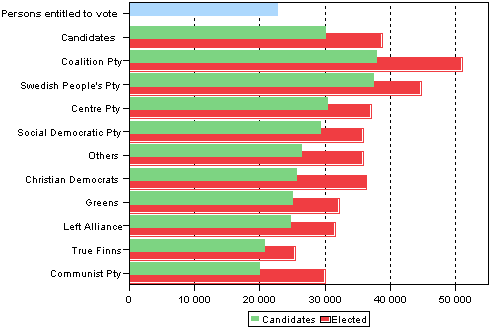
Average income (EUR) of persons entitled to vote, candidates and elected councillors by party in Municipal elections 2008
| Candidates | Elected councillors | |
| Persons entitled to vote | 22,994 | - |
| Candidates/Elected councillors, total | 30,344 | 38,753 |
| Coalition Pty | 38,207 | 51,002 |
| Swedish People's Pty | 37,658 | 44,764 |
| Centre Pty | 30,719 | 37,096 |
| Social Democratic Pty | 29,519 | 35,894 |
| Others | 26,696 | 35,833 |
| Christian Democrats | 25,874 | 36,423 |
| Greens | 25,292 | 32,202 |
| Left Alliance | 24,943 | 31,539 |
| True Finns | 21,024 | 25,505 |
| Communist Pty | 20,192 | 30,097 |
Candidates' average income by party compared to average income of persons entitled to vote by region in Municipal elections, %
| Persons entitled to vote | Candidates | Centre Pty | Coalition Pty | Social Democ. Pty |
Left | Greens | Christian Democrats | Swedish People's Pty | True Finns | Communist Pty | Others | |
| WHOLE COUNTRY | 100.0 | 132.0 | 133.6 | 166.2 | 128.4 | 108.5 | 110.0 | 112.5 | 163.8 | 91.4 | 87.8 | 116.1 |
| Uusimaa | 100.0 | 130.2 | 170.5 | 173.4 | 123.0 | 97.4 | 102.7 | 97.4 | 140.9 | 83.9 | 83.8 | 101.4 |
| Itä-Uusimaa | 100.0 | 139.2 | 182.9 | 165.5 | 115.7 | 129.8 | 98.6 | 112.1 | 134.8 | 87.2 | . | 181.0 |
| Varsinais-Suomi | 100.0 | 135.0 | 127.8 | 176.7 | 133.8 | 102.6 | 105.2 | 112.2 | 162.2 | 91.9 | 74.7 | 80.7 |
| Satakunta | 100.0 | 143.3 | 134.4 | 183.5 | 141.5 | 114.3 | 116.9 | 132.7 | . | 107.5 | 77.2 | 150.0 |
| Kanta-Häme | 100.0 | 144.4 | 129.8 | 194.2 | 134.6 | 123.0 | 117.4 | 126.2 | . | 120.2 | . | 108.3 |
| Pirkanmaa | 100.0 | 131.7 | 125.9 | 167.9 | 130.1 | 114.7 | 110.4 | 132.1 | . | 91.5 | 87.4 | 120.4 |
| Päijät-Häme | 100.0 | 138.9 | 124.4 | 168.5 | 135.7 | 115.0 | 106.9 | 133.1 | . | 100.5 | 85.0 | 143.3 |
| Kymenlaakso | 100.0 | 145.2 | 131.1 | 192.0 | 142.6 | 108.2 | 115.8 | 131.8 | . | 112.9 | . | 144.5 |
| South Karelia | 100.0 | 141.2 | 146.2 | 166.3 | 138.0 | 119.9 | 107.8 | 133.4 | . | 93.5 | 85.7 | 120.2 |
| Etelä-Savo | 100.0 | 145.4 | 158.8 | 174.8 | 140.1 | 106.2 | 116.9 | 106.2 | . | 96.9 | . | 131.3 |
| Pohjois-Savo | 100.0 | 139.6 | 149.2 | 176.0 | 145.0 | 118.6 | 103.2 | 116.4 | . | 97.0 | 90.6 | 103.4 |
| North Karelia | 100.0 | 139.0 | 149.6 | 169.0 | 137.1 | 118.1 | 109.7 | 116.3 | . | 95.2 | 116.2 | 114.8 |
| Central Finland | 100.0 | 136.1 | 137.1 | 159.0 | 141.5 | 120.4 | 115.8 | 117.5 | . | 94.4 | 76.2 | 128.4 |
| South Ostrobothnia | 100.0 | 141.9 | 152.1 | 162.9 | 130.7 | 111.9 | 147.8 | 119.7 | . | 103.8 | . | 121.8 |
| Ostrobothnia | 100.0 | 144.6 | 132.9 | 158.1 | 134.0 | 126.7 | 111.4 | 114.0 | 168.5 | 88.1 | . | 140.3 |
| Central Ostrobothnia | 100.0 | 138.6 | 151.4 | 152.7 | 123.3 | 110.9 | 126.1 | 139.5 | 188.7 | 113.2 | . | 100.8 |
| North Ostrobothnia | 100.0 | 134.8 | 141.5 | 163.4 | 129.9 | 121.5 | 120.4 | 104.4 | . | 92.7 | . | 100.6 |
| Kainuu | 100.0 | 144,5 | 153,2 | 187,7 | 144,6 | 119,5 | 134,5 | 152,8 | . | 82,8 | . | 137,3 |
| Lapland | 100.0 | 137,4 | 146,1 | 156,8 | 140,7 | 123,7 | 90,3 | 109,4 | . | 88,9 | 83,4 | 129,1 |
Elected councillors' average income by party compared to average income of persons entitled to vote by region in Municipal elections 2008, %
| Persons entitled to vote | Elected councillors | Centre Pty | Coalition Pty | Social Democratic Pty | Left Alliance | Greens | Christian Democrats | Swedish People's Pty | True Finns | |
| Whole country | 100.0 | 168.8 | 161.6 | 222.2 | 156.4 | 137.4 | 140.3 | 158.7 | 195.0 | 111.1 |
| Uusimaa | 100.0 | 215.1 | 449.1 | 252.3 | 168.6 | 143.5 | 127.0 | 168.2 | 185.5 | 111.8 |
| Itä-Uusimaa | 100.0 | 148.9 | 142.3 | 207.2 | 120.5 | .. | 97.8 | .. | 145.2 | 97.2 |
| Varsinais-Suomi | 100.0 | 177.3 | 152.2 | 228.4 | 170.6 | 133.0 | 137.0 | 159.1 | 207.0 | 123.8 |
| Satakunta | 100.0 | 173.4 | 157.1 | 221.0 | 169.7 | 150.6 | 197.0 | 167.0 | .. | 128.0 |
| Kanta-Häme | 100.0 | 205.2 | 177.5 | 310.5 | 163.7 | 148.8 | 169.9 | 174.1 | .. | 257.3 |
| Pirkanmaa | 100.0 | 173.5 | 151.7 | 215.5 | 159.5 | 141.8 | 136.2 | 219.9 | .. | 113.6 |
| Päijät-Häme | 100.0 | 176.5 | 151.6 | 216.2 | 161.0 | 187.3 | 137.1 | 177.5 | .. | 117.8 |
| Kymenlaakso | 100.0 | 187.7 | 147.7 | 264.3 | 171.2 | 132.8 | 139.0 | 218.1 | .. | 127.3 |
| South Karelia | 100.0 | 182.2 | 175.6 | 223.2 | 169.7 | .. | 182.4 | 212.3 | .. | 106.5 |
| Etelä-Savo | 100.0 | 174.9 | 178.3 | 217.4 | 160.6 | 115.1 | 179.7 | 145.3 | .. | 110.0 |
| Pohjois-Savo | 100.0 | 170.7 | 164.3 | 241.0 | 170.5 | 162.2 | 175.7 | 150.6 | .. | 109.4 |
| North Karelia | 100.0 | 180.1 | 190.1 | 239.0 | 170.1 | 172.1 | 119.1 | 144.7 | .. | 113.1 |
| Central Finland | 100.0 | 166.2 | 156.5 | 221.6 | 161.0 | 158.8 | 123.2 | 160.6 | .. | 99.0 |
| South Ostrobothnia | 100.0 | 180.2 | 177.9 | 223.3 | 166.5 | 127.4 | .. | 137.8 | .. | 135.4 |
| Ostrobothnia | 100.0 | 177.7 | 164.6 | 181.9 | 161.4 | 140.8 | .. | 152.4 | 191.9 | 116.5 |
| Central Ostrobothnia | 100.0 | 173.1 | 174.2 | 197.0 | 153.3 | 151.0 | .. | 241.1 | 275.0 | 130.9 |
| North Ostrobothnia | 100.0 | 159.7 | 160.9 | 192.9 | 151.1 | 153.6 | 165.7 | 141.6 | .. | 105.2 |
| Kainuu | 100.0 | 171.2 | 181.0 | 223.2 | 175.4 | 133.3 | .. | 159.7 | .. | 102.2 |
| Lapland | 100.0 | 169.3 | 170.6 | 212.0 | 182.4 | 146.2 | 125.2 | 117.7 | .. | 99.7 |
By party, the income of elected councillors differs rather much from that of persons entitled to vote in the area. The income of all elected councillors is 69 per cent higher than that of persons entitled to vote. Relatively the highest income is recorded for the elected councillors from the Centre Party in Uusimaa; their income is over four times that of the persons entitled to vote in Uusimaa. In Kanta-Häme the income of elected councillors from the Coalition Party is three times as high as that of persons entitled to vote. The difference in income among the Social Democrats is biggest in Lapland and Kainuu, among the Greens in Satakunta and among the Swedish People's Party in Central Ostrobothnia.
Persons entitled to vote, candidates (by party) and elected councillors by income bracket in Municipal elections 2008, %
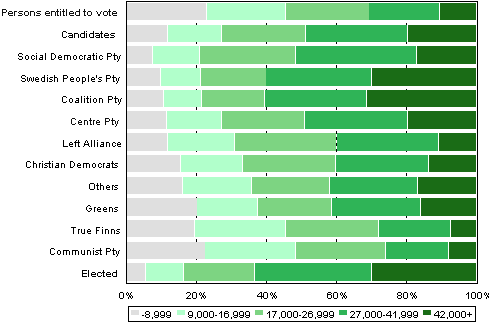
Persons entitled to vote, candidates (by party) and elected councillors by income bracket in Municipal elections 2008, %
| -8,999 | 9,000-16,999 | 17,000-26,999 | 27,000-41,999 | 42,000 + | |
| Persons entitled to vote | 23.1 | 22.6 | 23.8 | 20.1 | 10.4 |
| Candidates | 12.1 | 15.4 | 23.8 | 29.3 | 19.4 |
| Social Democratic Pty | 7.8 | 13.5 | 27.4 | 34.4 | 17.0 |
| Swedish People's Pty | 10.2 | 11.2 | 18.8 | 30.0 | 29.9 |
| Coalition Pty | 11.1 | 10.7 | 17.9 | 29.2 | 31.2 |
| Centre Pty | 11.7 | 15.8 | 23.8 | 29.3 | 19.5 |
| Left Alliance | 12.0 | 19.2 | 28.9 | 29.2 | 10.6 |
| Christian Democrats | 15.8 | 17.6 | 26.4 | 26.7 | 13.4 |
| Others | 16.4 | 19.7 | 22.2 | 25.2 | 16.6 |
| Greens | 20.5 | 17.1 | 21.3 | 25.3 | 15.8 |
| True Finns | 19.8 | 25.9 | 26.5 | 20.6 | 7.2 |
| Communist Pty | 22.8 | 25.8 | 25.6 | 18.1 | 7.8 |
| Elected councillors | 5.8 | 10.8 | 20.3 | 33.4 | 29.7 |
Candidates' earnings are better than average which implies that a bigger proportion of them belong to higher income brackets. The annual income of nearly one-half of the persons entitled to vote remains under EUR 17,000. Only 27 per cent of the candidates belong to this bracket. Slightly more than one-fifth of the candidates of the major parties belong to the two lowest income brackets. The earnings distribution of the candidates of the True Finns and the Communist Party is the closest to the average distribution of the persons entitled to vote. Thirty-one per cent of Coalition Party candidates, 30 per cent of Swedish People's Party candidates and 20 per cent of Centre Party candidates belong to the top income bracket, i.e. their annual income exceeds EUR 42,000. Ten per cent of the persons entitled to vote belong to this bracket. The number of persons with an average income (income bracket EUR 27,000-41,999) is highest in the Social Democratic Party, at 34 per cent.
Last updated 12.10.2012
Official Statistics of Finland (OSF):
Municipal elections [e-publication].
ISSN=2323-1114. 2008,
Municipal elections 2008 – who were the candidates and who were elected?
. Helsinki: Statistics Finland [referred: 31.12.2025].
Access method: http://stat.fi/til/kvaa/2008/kvaa_2008_2009-12-03_kat_001_en.html

